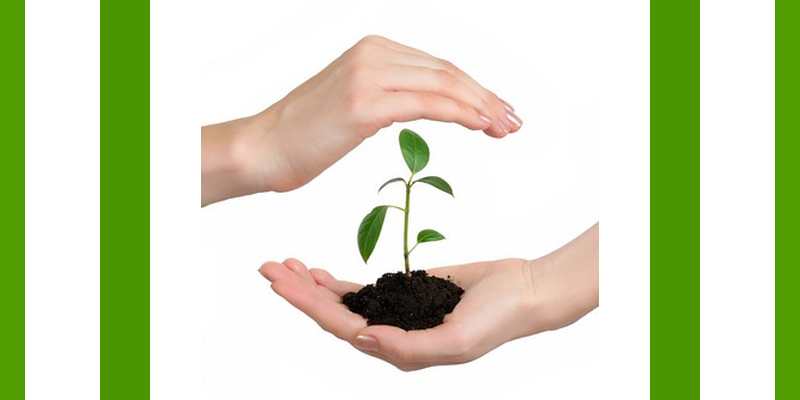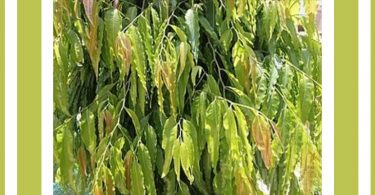Radko Tichavsky is a Czech born Mexican Agrohomeopath. He is a co-founder and director of Instituto Comenius in Mexico and author of Handbook of Agrohomeopathy, 2007 (Spanish) and Homeopathy for Plants, 2009 (Spanish), Organon de la Holohomeopatía and creator and teacher of Holohomeopathy.
He is now offering a one-semester virtual course in Holohomeopathy (in English). You can learn how to define and analyze holons and how to repertorize the specific homeopathic treatment beyond just disease or pest names. You can find out more here: www.icomenius.edu.mx
Many readers asked about Radko Tichavsky’s books. Below is a photo of them. They are available Spanish, Italian and Portuguese. For ordering or information: [email protected]
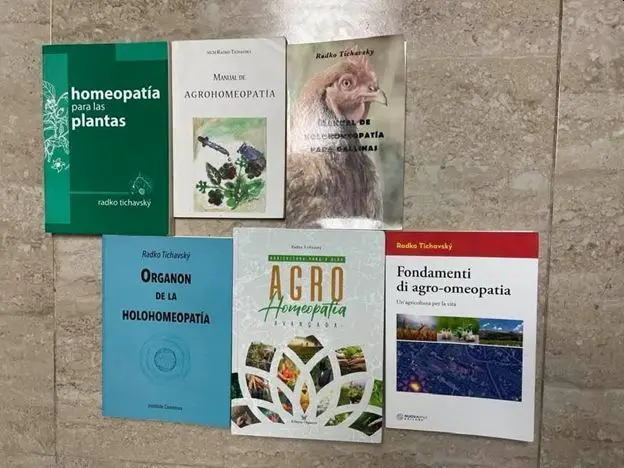
Dear Mr. Tichavsky,
We live in s Walnut Creek Ohio (mailing code: 44681) and have a number of crabapple trees. This last season many developed apple scab (Venturia inaequalis). We would like to avoid that next year if possible. Can you suggest a holo-homeopathic approach?
Walnut Creek, Ohio gets 39 inches of rain, on average, per year. The US average is 38 inches of rain per year, 25 inches of snow per year. On average, there are 172 sunny days per year.
Summer High: the July high is around 82 degrees
Winter Low: the January low is 19
Rain: averages 39 inches of rain a year
Snow: averages 25 inches of snow a year
Thank you
Anthony
Radko Tichavsky:
Dear Anthony,
Apple scab (Venturia inaequalis) is an Ascomycete fungus that is attracted to certain apple tree proteins (but can also affect other species such as Prunus sp. or Pyrus sp.) and allows the fungus to cross the epidermal barrier forming pseudoparenchymatous structures, called stromata, which lower the commercial value of the fruit.
Strategy based on the application of highly alkaline substances or application of synthesis fungicides when the fruits are already affected, generally do not give a lasting effect and on the contrary perpetuate the Venturia disease, turning it into a disease of epidemic and chronic proportions.
Although the disease starts to become active in the spring, when the fungal condidia develop on the leaves and then attack the fruit, the ideal time for treatment is precisely in October. The holohomeopathic intervention consists in stimulating microbial biodiversity in the trees (especially related to the presence of proteobacterias, mostly Pseudomonas).
The proteobacteria decompose the Venturia ascospores and restructure the conditions so that Venturia is not successful in the spring. Holohomeopathic treatment begins in the fall with the application of Urea at 3 JT * strength sprayed on fallen leaves.
One or two applications are made a week apart in the spring, and also applications of Kalium bichromicum at potency 12 JT* are made alternating with Salix babylonica 4 JT.
Additionally, and before flower formation occurs, live bionosode of Trichoderma viride and Microsphaeropsis sp. are applied at potency 4 JT.* Both fungi antagonize and parasitize Venturia inaequalis and the Trichoderma viride and the different species of Microsphaeropsis spp. are found naturally on decayed pine leaves.
It is necessary to collect about 20 l of pine leaves, to add them to 200 liters of non-chlorinated water and to add half kg of very well cooked rice until it forms a kind of soup, in which the rice grains are not recognized. The mixture is left to stand for 3 days, then a dynamization at 4 JT* power is prepared and sprayed on the trees and on the soil before the trees bloom.
Hello Dr. Radko,
Most backyard gardeners in Southern California USA who try to grow Avocado end up with dried leaf tips that slowly destroys the whole leaf. The only solution that I have come across is to flush the soil with lots of water since the drying of the leaves are attributed to excessive salt build up. This is not the best solution since if it is in a pot, it works well. In the ground it is difficult. Is there some other way to remedy this problem?
Regards,
Vijay
Radko Tichavsky:
Dear Vijay,
Excessive soil salinity is a growing problem not only in coastal areas but mainly in inland areas due to conventional agricultural management. The method of constant irrigation to keep salinity out of the reach of tree roots is expensive and only postpones the problem into a chronic condition of soil and plants.
Plants called halophytes, i.e. plants that have developed resistance to high levels of salinity such as Salsola tragus, Tamarix sp. or Heliotropium currasavicum among many others, contain halophyte microorganisms: bacteria and fungi useful to solve your problem.
Among the useful fungi are mycorhizae such as Glomus spp., Paraglomus spp., Claroideoglomus spp. and Funneliformis spp. that connect with the roots of the trees and filter the salinity so that it does not affect the root system of the avocado trees. Mycorrhizal fungi can develop mycelial networks several meters long. On the other hand, halophyte bacteria metabolize excess salts, for example Firmicutes.
Actinobacteria and Proteobacteria belong to this phylum of bacteria. We use live bionosodes from Larrea tridentata, Tamarix sp. Heliotropium currasavicum, Salsola tragus and Berberis sp.
The live bionosode is prepared in the following way: put roots of one of the mentioned plants (depending on their availability in the holon) and make a liquefied batch in a liter of non-chlorinated water, then filter it (you can use for example a coffee filter).
This liquid is considered as a mother tincture and dynamization is carried out at 4 JT* potency, alternating in each dynamization step the dilution in proportion of 1:100 and 500 vigorous succussions (in case of small volume) or 500 turns to the left and to the right carried out with a wooden stick in big volume.
Once the bionosode is prepared, it is added and applied around the trees. This procedure is especially effective in the fall season, the natural time for mycorrhizae inoculation and replication.
In this way your trees will get a defense against salinity and the problem of leaf necrosis will gradually disappear. A condition for a lasting effect of the application is to maintain a permanent and biodiverse green cover on the soil and not to turn over the soil layers since both agricultural management destroy the microbiota, both bacteria and mycorhizae.
Dear sir,
All our gourd plants: Ivy gourd, cucumber, bitter gourd, ash gourd, pumpkins, ridge gourd and snake gourd vines die off immature, due to severe attack of stem borer beetle grubs. These bore holes into stems and eat off its tissues from inside killing the part above the attacked area. It would be helpful to get a homoeopathic solution for this problem. I am from Chennai, India and now we are expecting Monsoons. It is warm and humid here now.
Thank you
Anoop Kumar C P
Radko Tichavsky:
Dear Anoop,
Mellitia cucurbitae can become a problem and destroy a major part of the crop if not properly controlled. It is very important to keep an annual crop rotation and not to produce cucurbits in the same place over and over again. Especially before the rainy season you can do mulching with newspaper and hay, combined with newspaper and hay, combined with tightly secured row covers on the plots as mechanical protection against stem borer beetle grubs.
Also, the use of yellow traps is very useful to locate the adults and to have updated information of their arrival in the orchard.
As for the preparations we use Azadirachta indica semen, a homeopathic preparation based on oil squeezed from the neem tree seeds at 4 JT* potency.
The application should coincide with maximum egg hatch, because the nymph stage is most vulnerable. Prepare live bionosode of Aloe vera from the gel extracted from the leaves (contains a rich community of Bacillus spp.) Bacillus thuringuensis is of special interest for the control of stem borer beetle grubs.
First prepare a liquefied gel in one liter of non-chlorinated water, and pour it into 200 liters of non-chlorinated water together with half a kg of rice cooked for a long time until it forms a kind of soup where you do not recognize the grains.
Then you wait a few days until foam appears on the surface of the liquid in the 200 liter container.
Use this liquid to prepare potency 3 JT and apply on the soil and on the plants as a spray before and immediately after noticing the presence of oviposition on the leaves, with 2 ml of neem tree oil for every 20 liters of application.
Dear Prof. Tichavsky,
I have an anthracnose problem with an azalea (photo below). Are the secondary metabolites of Ericacae are well known, the mineral constitutional remedy of Azalea Japonica or, better still, the constitutional functional remedy of this Ericacea, often affected by anthracnose or rust, despite microdoses of Trichoderma harzyanum?
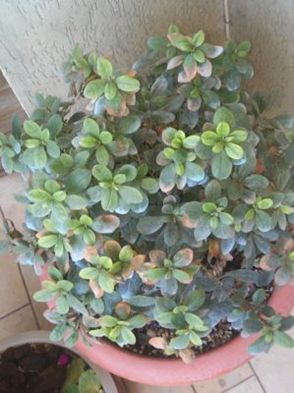
Thank you
Roberto Migliorelli – Roma
Radko Tichavsky
Dear Roberto,
There are many homeopathic remedies effective against anthracnose for example Sulphur 6 JT* but taking into account the species of each plant the remedy varies. Zincum metallicum, Niccolum metallicum both at potency 12 JT can provide the plant with adequate conditions to defend itself (both elements zinc and nickel are active as enzymatic and hormonal precursors).
You can apply as a corrective remedy the homeopathic dynamization of Pinus silvestris resinae at potency 4 JT or Boswellia sacra resinae 4 JT (made from the incense used in churches).
Dear Plant Doctor,
My vegetable plants in containers, mainly tomato, brinjlal and cucumber are infected with root knot nematodes. The infected plants look unhealthy, need more watering and slowly die. The infected plant roots are full of knots.
I used biological products on infected plants made from a strain of paecilomyces lilacinus and also Trichoderma Viride but that was not very effective. Can you suggest a remedy for this? Also how to reuse that soil? I am in Bangalore, India.
Thanks,
Murali
Radko Tichavsky:
Dear Murali,
The strategy of applying commercial products of biological control for the problem of phytopathogenic nematodes in crops can be ineffective because Paecilomyceslilacinus as Trichoderma viride usually works effectively under the condition of finding in the soil a rich biodiversity of metabolic friends (micro, meso and macrorganisms that collaborate with them.
If these conditions are not present, then the survival of commercial strains without of the cluster of other organisms does not survive for long and shows little efficacy.
The most useful strategy in nematode control is to increase the biodiversity of nematodes, since there are phytopathogenic nematodes, bacteria-eating nematodes, fungivorous nematodes, omnivorous nematodes and nematodes that eat nematodes.
One of the ways to attract omnivorous nematodes and nematode-eating nematodes is to prepare Rumex radix, a live bionosode from Rumex sp. roots. It should be noted that this procedure is effective prior to planting the plants because once the phytopathogenic nematodes penetrate the root system of the plant, their enemies will not be able to reach them.
Another preventive strategy is to add river sand to your planting beds to increase drainage. Phytopathogenic nematodes prefer clay soils and when they find soil with better drainage they will avoid it.
Nematodes in general also prefer soils contaminated with heavy metals, and with the application of Opuntia ficus indica 6 CH you can reduce this toxicity and chelate it and also avoid the presence of phytopathogenic nematodes.
As for the already infected plants you can apply Berberis vulgaris 6 CH and Cina 6 CH alternated. In Mexico we also use Larrea tridentata 6 JT, Chenopodium album radix 6 JT, Chrysanthemum coronarium 6 JT or Lantana camara radix 6 JT.
Remember that even with controlling phytopathogenic nematodes on plants to establish a durable balance in the soil you must focus on increasing the biodiversity of nematodes that feed on nematodes, bacteria and fungi including omnivorous nematode species.
Hello Mr. Tichavsky,
It’s the very beginning of autumn here in Michigan, USA. Something appears ill here for this tree. Do you know what it is and what remedy can help? (Photos below)
I’m in Rochester Hills, MI 48306 (U.S.)
In Rochester Hills, the summers are warm; the winters are freezing, dry, and windy; and it is partly cloudy year round. Over the course of the year, the temperature typically varies from 19°F to 83°F and is rarely below 4°F or above 91°F. Rochester Hills, Michigan gets 32 inches of rain, on average, per year. The US average is 38 inches of rain per year. It averages 33 inches of snow per year.
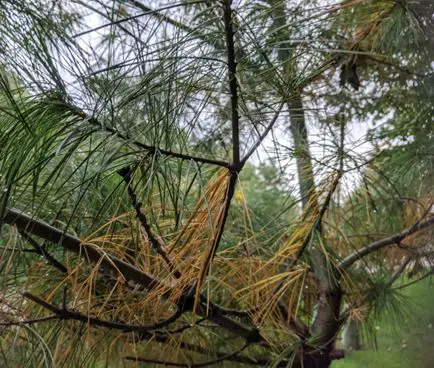
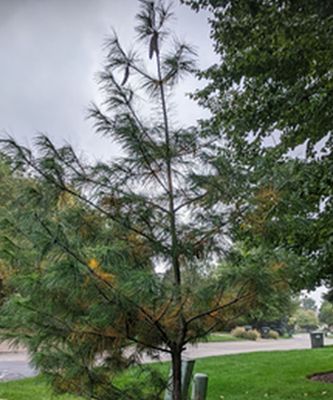
Thank you
Theresa Laehn
Radko Tichavsky:
Dear Theresa,
The presence of yellowing in pine trees starting on the lower branches often refers to a deficiency of one of the macronutrients (nitrogen, phosphorus or potassium), especially the presence of ozone at ground level can contribute also to this yellowing.
This is very frequent in urban areas and even in rural areas since ozone is easily moved by the wind. But the most frequent cause is planting trees in the middle of grass in park areas without the necessary mycorrhization, i.e. a pine tree. In order to grow healthy it requires the presence of ectomycorrhizal and endomycorrhizal fungi that protect itself from climatic fluctuations and above all make it immune to drought, but also constitute a defense against various pathogens.
Pines planted in the grass (an unnatural environment for them) and overall without mycorrhizae present, marked nutritional deficiencies because mycorrhizal fungi not only protect the trees but also make bioavailable macro and micronutrients necessary for their growth.
The solution for this particular young pine tree is to apply live bionosode made from the mulch collected (precisely in this autumn season) under large and healthy adult pines in a mixed forest.
In the first 5 centimeters of the mulch there are numerous mycorrhizal fungi that must be inoculated in the form of live bionosode to complete the health of this pine.
You must collect mulch in the forest and fill half of a 20 liter bucket, add one liter of carbonated water (water with CO2 without any other additive) and complete the bucket with non-chlorinated water.
Leave the bucket for 24 hours, then filter the content and dynamize the liquid at 3 JT* potency by watering or spraying the homeopathic remedy around the tree from one meter away from the tree trunk to where it reaches the top of the tree around the trunk.
In this way you will inoculate the necessary beneficial microorganisms and the tree will recover its health and will survive with their help the nutritional deficiencies of phosphorus mainly in a sustainable way.
* Editor’s Note: JT (Jenichen/Tichavsky) potency is centesimal dilution followed by 500 succussions or five hundred continuous turns with a wooden stick to the right and 500 turns to the left (if handling larger volume). The JT potency frequently has a better reaction in plants and it is very important in preparation of live bionosodes.



